5 - Reproduction and life history
Published online by Cambridge University Press: 29 October 2009
Summary
Constraints peculiar to forest canopy habitats helped shape epiphyte natural history, but the selective forces are not always apparent. Some characters and lineages appear to have been affected more than others; for instance, iteroparity is nearly routine in the group, whereas breeding mechanisms and modes of pollen and seed dispersal are much more diverse. Multiple paths to similar ends complicate the search for a common theme. Enough data are available, however, to offer tentative judgments on several aspects of the plant life cycle that permit success in tree crowns. This chapter deals with such aspects and the factors responsible for their existence.
Breeding systems
Pollination: identity of vectors
If breeding systems differentiate terrestrial from canopy-based pteridophytes, the fact remains unreported. Comparisons of angiosperms are easier, and pollination has been studied in numerous epiphytic flowering plants, especially neotropical Orchidaceae. Pollinators of these taxa tend to be more species-constant and specialized than those serving nearby terrestrials, although sharing of pollinators is sometimes possible. Avians are especially important in northern South America, where nectar-feeding birds and the flora they serve reach unparalleled diversity. Large, heavily ornithophilous families include Bromeliaceae, Ericaceae, Gesneriacese, and Loranthaceae; birds frequently pollinate Cactaceae, Marcgraviaceae (Norantea), and Rubiaceae (Ravnia, Manettia) as well. The relationship between epiphytism and avian pollination is particularly apparent in families with diverse floral syndromes. Ornithophily in Bignoniaceae is rare except in two epiphytic genera: Gibsoniothamnus is entirely pollinated by birds, Schlegelia partly so (Gentry and Dodson 1987b).
- Type
- Chapter
- Information
- Vascular EpiphytesGeneral Biology and Related Biota, pp. 152 - 183Publisher: Cambridge University PressPrint publication year: 1990



